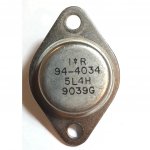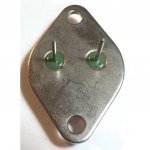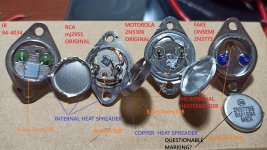There is an auction on *bay with reasonable price for this part. Have you any idea about what is the actual part number for this mosfet? Seller claims that it is IRFP3710 equivalent but there is no such supporting info.
Attachments
Hi all,
I know it's and old post but i want to write anyway and i signed up forum just to reply this post🙂
I purchased 5 piece of this MOSFET's and tested them briefly.
First of all MOSFET is not "IRFP3710" obviously but and old auction site from japan might solve this.
If you search google with search terms "94-4034 IRF350" that japan site will appear. Here is translation of that page.
Translation says:

And here are some test photos:
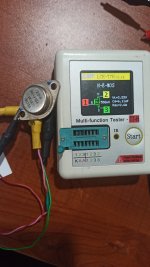
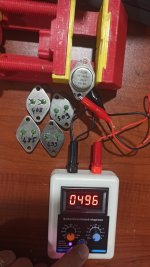
Take these measurements just a bit grain of salt but it seems MOSFETS are genuine and i believe it's an IRF450 if we look Drain to Source Breakdown Voltage. I know it's a common practice to semiconductor manufacturers underspec that breakdown voltages. It seemed to me 60v overspec is more logical than 160v overspec but who knows.
Anyway i might remove metal lid and take a picture of die if someone wishes. Or i might load test MOSFET's if someone have any idea.
What are your thoughts?
I know it's and old post but i want to write anyway and i signed up forum just to reply this post🙂
I purchased 5 piece of this MOSFET's and tested them briefly.
First of all MOSFET is not "IRFP3710" obviously but and old auction site from japan might solve this.
If you search google with search terms "94-4034 IRF350" that japan site will appear. Here is translation of that page.
Translation says:
So we assume International Rectifier 94-4034 can be an IRF350 or IRF450. I tested them with a "component tester" and "voltage withstand tester(A.K.A. FAKE component tester)" here are some results for your comments:Product Description
It was a TO-3 type element that had been stored , but its specifications were unknown.
There were several IRF-450 and IRF-350 mixed in, so I measured them assuming they were the same product.
I was able to confirm the same operation.
It seems that they were used in large quantities (including in parallel) in power supply equipment .
The standard seems to be for use in 400 to 500 V , 12 to 14 A high-speed switching elements.
Now that metal elements are no longer available, MOS-FET metal capacitors are rare.
Like Hitachi's MOS type, the bias is a little deep, but it is a high-speed, large-capacity transistor that can be used for audio applications.
And here are some test photos:


Take these measurements just a bit grain of salt but it seems MOSFETS are genuine and i believe it's an IRF450 if we look Drain to Source Breakdown Voltage. I know it's a common practice to semiconductor manufacturers underspec that breakdown voltages. It seemed to me 60v overspec is more logical than 160v overspec but who knows.
Anyway i might remove metal lid and take a picture of die if someone wishes. Or i might load test MOSFET's if someone have any idea.
What are your thoughts?
Thank you @whitepawn for informative analysis. I don't believe such thing as "old post" as long as we can bring up any additional info. These hexfets can make a good output stage for "quasi" amplifiers like Circlophone.
Thanks for all your comments. I believe mosfet gods needed a sacrifice so i called my executioner "dremel".
Casing is not copper (from its colour) but it must be a corrosion resistant metal or alloy since no sparks produced while i was cutting cap with dremel. Mosfet casing, internal heat spreader and mosfet caps seems same material but in different form and thickness.
I was socked when i lifted cap because of huge die. (Maybe older process node? Maybe distance must be long for high voltage withstand? ) I have never cut open TO-3 metal mosfets so i am clueless what to expect but i cut TO-3 metal transistors many times on past. So i compated them side to side. I compared 94-4034 with whatever lying around my workshop there is no patricular reason.
I know comparing mosfets with transistors is wrong but here are some results:


I believe it is a genuine part from IR but to be sure which one it is i search all over internet to see IRF350 and 450 inside but i had no luck finding such mosfet die pictures. If someone finds it we can compare.
I have a cheap "microscope" and looked die for any info. There some markings on die but i couldn't read them at all. Maybe i will find a proper microscope and read them. Here are some close shots of die videos:
BTW it still lives after surgery:

And can produce 315mV under 6.5W LED workshop light:

I may test some parameters also. If i do i will post them here.
Casing is not copper (from its colour) but it must be a corrosion resistant metal or alloy since no sparks produced while i was cutting cap with dremel. Mosfet casing, internal heat spreader and mosfet caps seems same material but in different form and thickness.
I was socked when i lifted cap because of huge die. (Maybe older process node? Maybe distance must be long for high voltage withstand? ) I have never cut open TO-3 metal mosfets so i am clueless what to expect but i cut TO-3 metal transistors many times on past. So i compated them side to side. I compared 94-4034 with whatever lying around my workshop there is no patricular reason.
I know comparing mosfets with transistors is wrong but here are some results:
I believe it is a genuine part from IR but to be sure which one it is i search all over internet to see IRF350 and 450 inside but i had no luck finding such mosfet die pictures. If someone finds it we can compare.
I have a cheap "microscope" and looked die for any info. There some markings on die but i couldn't read them at all. Maybe i will find a proper microscope and read them. Here are some close shots of die videos:
BTW it still lives after surgery:
And can produce 315mV under 6.5W LED workshop light:
I may test some parameters also. If i do i will post them here.
Attachments
- Home
- Design & Build
- Parts
- Unknown IR mosFET with 94-4034 part number
